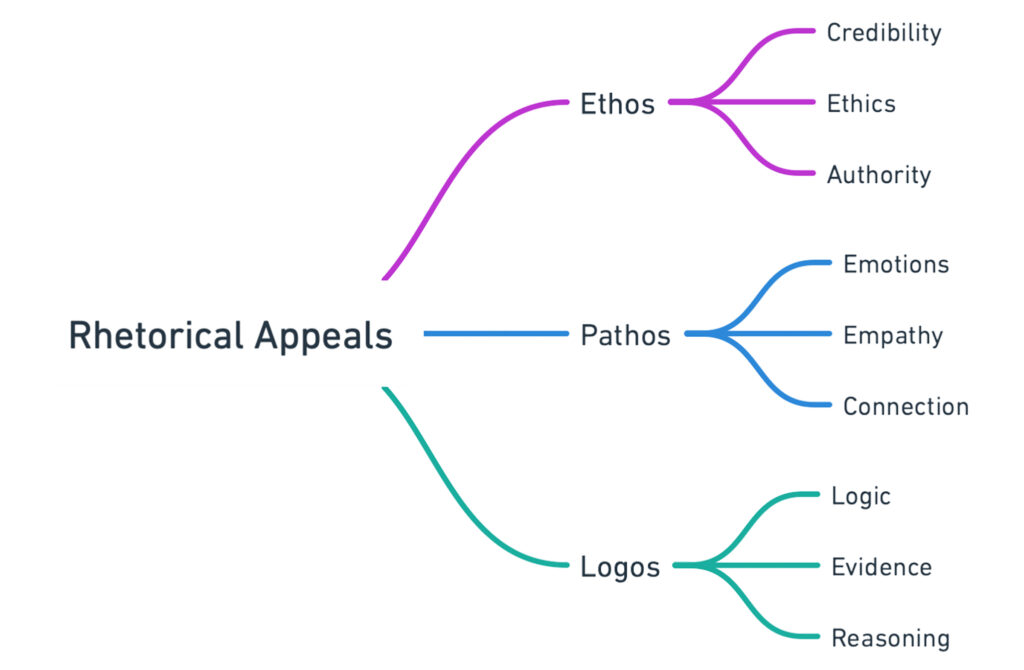What is rhetoric?
Rhetoric is the art and skill of persuasive communication. It refers to using spoken and written language to influence and persuade an audience. Rhetoric encompasses various techniques and strategies to convey messages, sway opinions, and inspire action effectively.
The study of rhetoric dates back to ancient Greece, where it was considered a crucial discipline for public speakers, politicians, and philosophers. Rhetoric was seen as a means to achieve effective and persuasive communication, utilizing persuasive techniques such as logical reasoning, emotional appeal, and ethical arguments.
The study of rhetoric helps individuals develop practical communication skills, critical thinking abilities, and the ability to analyze and evaluate persuasive messages.
Rhetorical appeals
In classical rhetoric, three main persuasive appeals are known as the “modes of persuasion” or “rhetorical appeals.”
- Ethos: Ethical appeal refers to establishing credibility and trustworthiness. It involves presenting oneself as knowledgeable, experienced, and possess good character or moral standing.
- Pathos: Emotional appeal aims to evoke specific emotions in the audience. Using vivid language, storytelling, or appealing to shared values and beliefs, speakers or writers can elicit their audience’s empathy, compassion, or passion.
- Logos: Logical appeal relies on reason, evidence, and logical arguments to support a claim. It presents a persuasive case using facts, statistics, expert opinions, and logical reasoning.

Rhetoric also involves using rhetorical devices such as metaphor, simile, analogy, repetition, irony, and rhetorical questions. These devices add emphasis, create memorable images, and engage the audience emotionally or intellectually.
- Kairos (the opportune moment): Kairos refers to timing and recognizing opportune moments for communication. It emphasizes the importance of delivering the right message at the right time to maximize its impact and effectiveness.
- Arrangement (disposition): Arrangement involves organizing the elements of a speech or written communication coherently and logically. Classical rhetoric typically follows a five-part structure: introduction, narration, confirmation, refutation, and conclusion.
- Style (elocution): Style pertains to using language, figures of speech, and rhetorical devices to make the message more persuasive, memorable, and aesthetically appealing. It involves diction, sentence structure, tone, and figurative language choices.
- Memory: Memory refers to speakers’ techniques to retain and recall critical elements of their speech without relying heavily on notes. This involved mentally organizing and visualizing the structure of the speech.
- Pronunciation: Pronunciation focuses on the effective delivery of the speech, including tone, volume, pace, and gestures. It involves using vocal and physical elements to engage the audience and convey the message more convincingly.
- Invention: Invention generates and develops arguments and ideas to support the speaker’s persuasive goals. It involves finding relevant evidence, examples, and reasoning to support claims and assertions.
- Topics: Topoi are commonplaces, or topics speakers draw upon when constructing arguments. They are general themes or premises that can be applied to various situations, aiding in generating arguments.
- Stasis theory: Stasis theory helps determine the central point of disagreement in a debate or argument and identifies the key issues that must be addressed. It classifies arguments into different categories to facilitate effective rebuttals.
- Delivery: Delivery encompasses the overall performance and presentation of the speech, including body language, facial expressions, eye contact, and gestures. Effective delivery enhances the speaker’s credibility and engagement with the audience.
- Audience analysis: Analyzing the audience’s characteristics, beliefs, and values is essential for tailoring messages effectively. Understanding the audience helps speakers adapt their rhetoric to resonate with the listeners’ perspectives and interests.
Why study rhetorical theory?
While rhetoric is often associated with public speaking and persuasion in the political and oratory contexts, it also applies to various forms of communication, including written texts, advertising, marketing, law, and even everyday conversations. The study of rhetoric helps individuals develop practical communication skills, critical thinking abilities, and the ability to analyze and evaluate persuasive messages. This is critically important, especially as we enter a world where artificial intelligence will change many aspects of communication.
These aspects of rhetorical theory collectively provide a comprehensive framework for understanding the art of persuasion and effective communication in various contexts, from public speaking and writing to interpersonal interactions and mass media messages.
